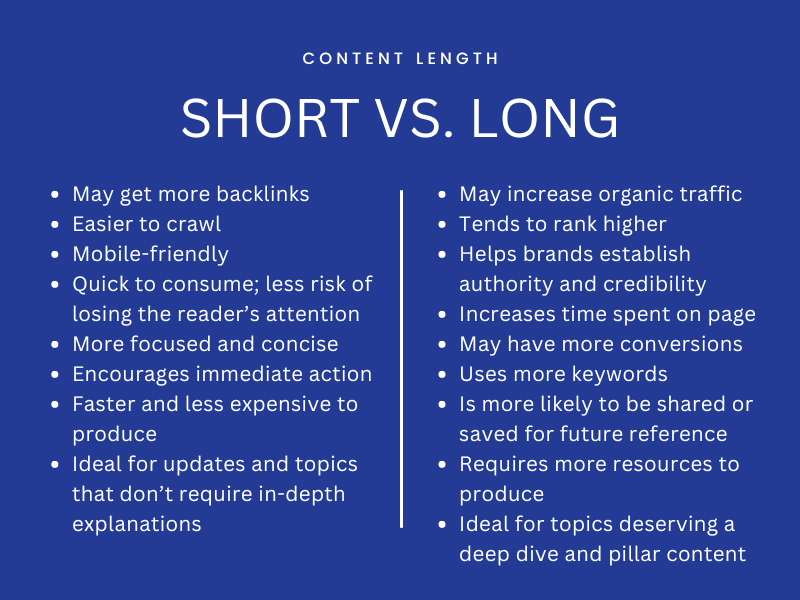For years, the short-form vs. long-form content debate has caused marketers to scratch their heads. There’s plenty of evidence to make a strong case for both when it comes to search rankings:
- 43% of people say they skim blog posts, which wins a point for short content.
- The average blog post is 1,376 words, which gives a point to long content.
- The average human attention span is just 8.25 seconds, another win for short-form content.
- There’s a moderate correlation between long-form content (up to 2,000 words) and organic traffic.
Specifically for SEO and organic traffic, you’ll need to decide whether to create short or long blog posts. Let’s dig into the differences between short-form and long-form content and how to use them to drive your content strategy.
What Is Short-Form Content?
Short-form content refers to content that delivers information quickly and efficiently. In blogging, we consider anything that’s 1,000 words or under as short-form.
Or put another way, any content that the reader can finish in less than five minutes. The average person reads at a pace of 200-300 words per minute (when reading silently). At 200 words per minute, that’s up to 1000 words in five minutes.
The beauty of short-form content is its ability to share impactful information creatively. It takes effort to write less: you’re choosing your words carefully and ensuring only the most essential information makes it into the final draft.
In a world overflowing with information, the power of being succinct cannot be overstated; it allows creators to cut through the noise and speak directly to their audience’s needs.
What Is Long-Form Content?
Long-form content in blogging is anything over 1,000 words. These blog articles are usually deep dives into a specific topic. They’re more comprehensive and give readers a chance to explore a topic from all angles.
Naturally, long-form content takes longer to read. It’s ideal for helping brands to establish authority and credibility. Long-form takes more effort to create, and it’s often viewed as more valuable to the reader (and search engines).
How Content Length Affects SEO
When it comes to ranking higher in search results, there is no magic word count. However, hints about how algorithms rank content can give us some clues about whether you should create short-form or long-form content.
Long-Form Content Increases Time Spent On Page
Longer content takes more time to read, which can increase dwell time on your blog. Dwell time refers to the amount of time users spend on a specific page. The longer the dwell time, the more authoritative your content appears to search algorithms.
Even if your readers don’t take any other action (i.e., they bounce from your website), longer dwell time can help to offset the impact. Your readers get the information they came for, which can make your content appear more valuable, and therefore, more likely to rank higher in search engines.
Long-Form Content Uses More Keywords
The longer your content, the more opportunities you have to optimize it for search. You’ll have more ways to work in keywords that will give context to your content. Search engines can better understand your content when you use the right keywords in the right places.
Short-Form Content is Easier to Crawl
Search engines don’t read your content word for word. Longer content takes longer to crawl, so search bots might not finish crawling your page before indexing it.
This gives short-form content an advantage. Short content has a better chance of being read in its entirety, which can help with indexing and ranking.
Short-Form Content May Get More Backlinks
Data from Ahrefs shows that there’s a strong positive correlation between word count and backlinks, but only up to 1,000 words. After that, there’s a strong negative correlation between word count and backlinks.
Backlinks are a signal of quality and authority to search engines. They’re also sources of referral traffic. Both backlinks and referral traffic can help your content rank higher in search results because it shows other people trust your content.
Benefits of Short-Form Content
There are times when short-form content has advantages over long-form content. These include but are not limited to the following:
- Short content is mobile-friendly because there’s less scrolling involved.
- It’s quick to consume, which means your readers are more likely to read it in its entirety.
- There’s less risk of losing the reader’s attention.
- It’s faster and less expensive to produce short content.
- It’s ideal for topics that don’t require in-depth explanations.
- You can be more focused and concise.
- It encourages immediate action.
You can use these benefits to your advantage when developing your content calendar.
Benefits of Long-Form Content
Long-form content continues to hold an edge over short-form content for many reasons. These include the following:
- Long-form content tends to rank higher in search results.
- Longer content allows for a deep dive into specific topics.
- Long content can establish authority and demonstrate expertise.
- It takes more resources to create long content, which can add to a brand’s credibility.
- Readers spend more time on the page, which can indicate a high level of quality.
- In-depth, valuable content is more likely to be shared or referenced in the future.
- Detailed posts can build trust with your audience, showing that you’ve done your research.
- Longer posts give you more space to build your argument and persuade readers, which can lead to higher conversion rates.
- Long-form content tends to have a longer shelf life and continues to attract readers over time.
While long-form is still a dominant force in SEO, marketers are also adding more short-form, people-first content to the mix to get the best of both worlds.
Why You Need Both Long-Form and Short-Form Content
When it comes to choosing short-form vs. long-form content, there is no silver bullet that guarantees better rankings. The data is mixed on the two, which ultimately tells us there’s an opportunity for both short and long blog posts to rank.
This is especially important if you’re new to blogging. You don’t have the benefit of knowing what your audience likes and responds to, so mixing up short and long content can help you A/B test your content strategy. Having a mix of both types lets you enjoy the strengths of each.

Tips for Deciding How Long Your Content Should Be
The topic you’re writing about ultimately determines how long your content should be. Use these tips to choose an optimal length and get the most SEO benefits from each blog post.
Know What Your Audience Likes
Know who your readers are and what they expect from your content. If they prefer in-depth analysis, longer posts might work better. If they prefer quick reads, shorter posts might be more effective.
Prioritize Quality over Quantity
Your readers don’t have time for poorly written content. Don’t just fluff your content to make it seem longer and keep your reader on the page, as this can often have the opposite effect. Quality will always win over word count.
Consider the Topic Complexity
More complex topics require longer posts to fully cover the subject. Simpler topics can often be covered effectively with shorter content.
See What’s Already Ranking for Your Topic
Do a quick Google search to see how long the top-ranking content is for your topic. This gives you an inside look at what Google deems suitable for your search, and you can mirror that length in your own content.
Consider Your Content Goals
Define the purpose of your blog post. If your goal is to drive traffic through SEO, longer posts often rank better. If the goal is to provide a quick update or tip for a newsletter or social media post, shorter content might be sufficient.
Keep Engagement Top of Mind
Keep in mind that some topics warrant longer conversations, while other topics don’t. If you can say it in fewer words, do so. You reduce the risk of people bouncing from your blog post when you can get to the point quickly.
Test and Measure Your Content Performance
Experiment with different content lengths and track performance. Analyze metrics like time on page, bounce rates, and conversions to see what works best for your audience.

